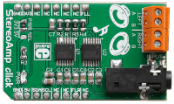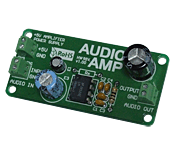|
|
| |
|
 | Search: |
|
|
 |

|
|
AudioAmp click is a mikroBUS add-on board that functions as a mono audio amplifier. It is driven by a Texas Instruments LM48100Q-Q1 Boomer Mono, 1.3W Audio Power Amplifier IC.
AudioAmp click has one 3.5 mm input jack and next to it screw terminals for connecting output wires to a passive speaker. It has dual audio inputs that can be mixed/multiplexed to the device output. Each input path has its own independent, 32-step volume control. The mixer, volume control and device mode selection are controlled through the mikroBUS I2C interface.
Fault detection is another important feature of LM48100Q. It senses the load conditions, protecting the device during short circuit events, as well as detecting open circuit conditions.
AudioAmp click can work either on a 3.3V or a 5V power supply. There's an additional jumper for selecting the I2C address as well. The open-drain output fault flag. FAULT is routed through the default mikroBUS INT pin (0 indicates that a fault condition has occurred). |
|
|
|
|
 |

|
|
StereoAmp click functions as a stereo amplifier and is ideal for battery operated devices or as a lab amplifier. It features two LM48100Q-Q1 Boomer single supply, mono, bridge-tied load amplifier ICs by Texas Instruments. The LM48100Q-Q1 has output fault detection and I2C volume control.
The StereoAmp click features a 3.5mm input jack and four output screw terminals for connecting passive speakers. It runs on either 3.3V or 5V power supply and communicates with the MCU through the I2C interface. |
|
|
|
 |

|
|
2x5W AMP click functions as an amplifier and features the TDA7491LP 2x5-watt dual BTL class-D audio amplifier. The click is designed to run on either 3.3V or 5V power supply. It communicates with the target MCU over the following pins on the mikroBUS™ line: AN, RST, CS, PWM, INT. |
|
|
|
 |

|
|
The AudioAMP Board features an on-board power amplifier LM386 designed for use in low voltage consumer applications. The quiescent power drain is only 24 milliwatts. The board can be connected to your prototype device via on-board screw terminals. |
|
|
|
 |
|
|

